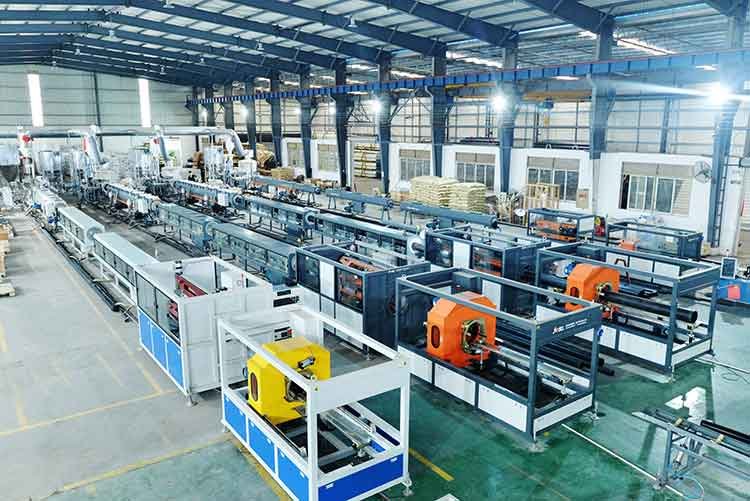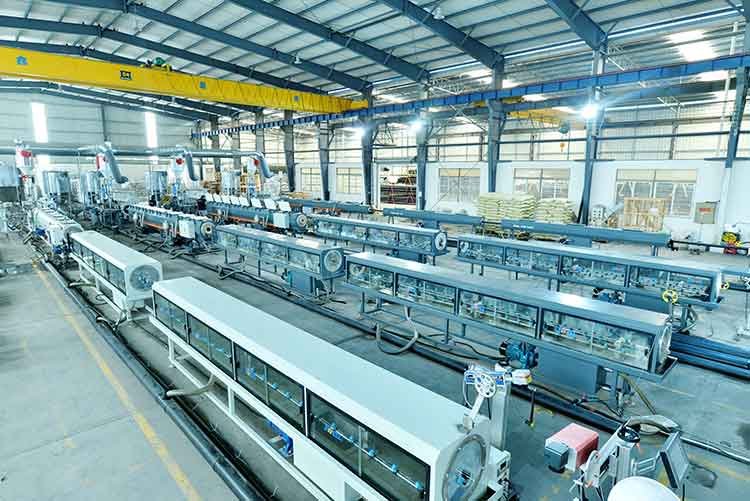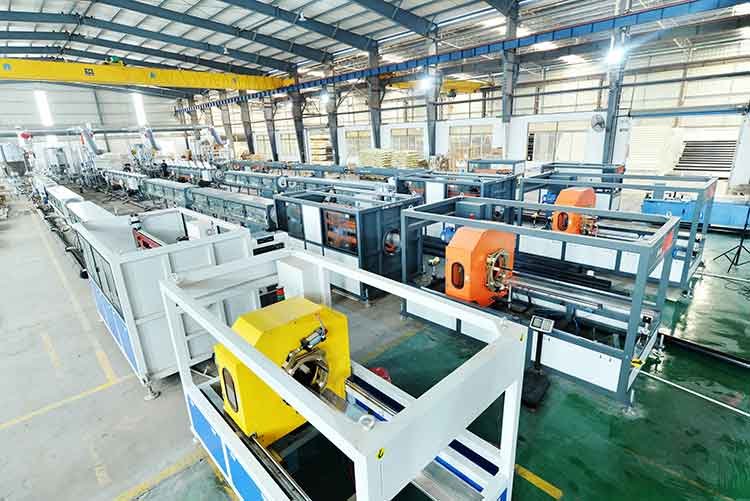One of the major machines that has revolutionized the plastic pipe manufacturing industry is the extruder.
It’s a versatile, multipurpose, and lightweight extruder that can perform a wide range of tasks. Whether it’s melt plasticization, mixing and homogenization, forming, degassing and devolatilization, or modification, you can use an extruder for all of it.
In this guide, we will explore all the key aspects of this machine – from its definition, types, functions of each section, operation, components to its working principle.
What is an Extruder?

An extruder is an industrial device used to melt and extrude materials such as plastics and rubber. It is mainly divided into two types: single-screw and twin-screw. Its working principle is to plasticize solid materials into a uniform melt and continuously extrude them into shape through the shear force, pressure and external heating generated by the rotation of the screw.
Types of Extruders and Their Uses
Single screw extruder
It consists of a transmission system (motor + reduction gear), an extrusion system (barrel + screw) and a temperature control system, and is suitable for continuous production of pipes, profiles, etc. For example, the ZJL-200B model is equipped with a touch screen operation and an air-cooled mixer, supporting laboratory-level precision control.
Twin-screw extruder
The twin-screw extruder works in tandem, making it suitable for high-precision mixing and complex material processing. For example, it can adjust moisture, temperature, and fiber structure in the development of plant-based proteins.
Common extruder components

Feed Zone
The feed zone is the raw material storage area of the extruder. Raw materials are loaded into the feed zone in the form of granules or powder and then conveyed downstream by a rotating screw.
Screw
The screw is the core component of an extruder. It consists of a series of threads and is typically located within a barrel. The screw’s primary function is to heat, melt, mix, and propel the raw materials forward. The screw’s structure and thread shape can be adjusted to suit different materials and product requirements.
Barrel
The barrel is a cylindrical container that houses the screw. It’s typically made of special alloys or coatings to withstand high temperatures and pressures. Its primary function is to heat and melt the raw materials while maintaining a constant pressure.
Heating and Cooling Systems
Extruders are typically equipped with heating elements, such as electric heaters or heating tapes, to heat the raw materials to their melting point and control the temperature. Cooling systems are also required to ensure that the extruded product cools quickly and maintains the desired shape.
Die or Extrusion Head
The die or extrusion head determines the shape and dimensions of the final product. Raw material flows through the extruder head and is further processed into the desired product, such as pipes, films, and profiles.
Extruder Control System
The control system monitors and controls various extruder parameters, such as temperature, pressure, and screw speed. Adjusting these parameters is crucial to ensuring product quality.
Cutting and Winding Systems
Certain products, such as pipes or films, need to be cut to specific lengths or wound into rolls after extrusion. These systems handle these processing steps.
Drive System
Drive systems provide the power required to rotate the screw and move other mechanical components. Typically, these systems consist of an electric motor, a speed reducer, and a transmission.
Function of each section of the extruder

The single screw extruder is a three-stage extruder, which consists of the feeding, reducing and extrusion sections.
Feeding Section
Extrusion feedstock is typically granular. The feeding device, also known as a hopper, ensures continuous material flow into the extruder barrel. It resembles a Büchner funnel and comes in conical or square-conical shapes. The bottom of the hopper, where it meets the barrel, is the feed port, equipped with a shut-off device to regulate and shut off the material flow. Cooling clamps surround the feed port to prevent heat transfer from the high temperature of the material stream to the hopper, preventing the plastic inside the hopper from heating and becoming sticky, which could lead to uneven feeding and obstructed material flow. The side of the hopper features a glass viewing port and calibration and measurement devices. Some hoppers also have a heat-drying vacuum pressure relief device to prevent the plastic from absorbing moisture from the air, a stirring device to prevent “railway bridges” caused by powdered plastic, and a device that automatically feeds the material at regular intervals.
Shrink segment
The barrel, also known as the extruder, is a metal cylinder subjected to heat and stress. The melting and shrinking of the material occurs entirely within the barrel. The operating temperature during extrusion is typically between 180°C and 290°C, with the internal pressure reaching 60 MPa. Heating and cooling devices are installed outside the barrel, typically in three or four stages. Commonly used are resistor or inductor heaters, though radiant heating is also an option. The purpose of cooling is to prevent overheating of the plastic or to rapidly cool the plastic during shutdown to prevent melting. Cooling is typically achieved using air or water cooling. The barrel must withstand high pressure and must possess sufficient compressive strength and rigidity, with a smooth interior. The barrel is generally used to prevent wear and corrosion. Friction from overheating the plastic is prevented by friction, while also keeping the extruder screw surface slightly cooler than the barrel to prevent material from adhering to it and facilitate material transport.
Extrusion Section
The extruder screw is suspended in the center of the barrel using a thrust bearing, aligned with the barrel axis without significant deviation. The minimal clearance between the extruder screw and the barrel allows the plastic to be subjected to a strong shearing force, melting and propelling it forward.
Understand how extrusion works
The working principle of the extruder is to plasticize the solid material into a uniform melt and continuously extrude it into shape through the shear force, pressure and external heating generated by the rotation of the screw.
Material Conveying Stage
Solid raw materials enter the barrel from the hopper and are pushed forward and compacted by the friction of the rotating screw, while remaining solid.
The conveying section of the single-screw extruder features a deep spiral groove design to ensure efficient conveying.
Plasticization and Compression Stage
The screw channel volume gradually decreases, and the material melts due to shear forces and external heating. Approximately 80% of the heat comes from mechanical shear and 20% from external heating.
Twin-screw extruders achieve more uniform shear and mixing through the “O-shaped” motion of the intermeshing screws.
Metering and Extrusion Stages
The melt is precisely controlled in the metering stage for flow and pressure, and then formed into the desired shape (such as a tube or film) through the die.
Temperature stability is crucial for ensuring product quality.
How to maintain the extruder
First, the extruder equipment should be placed in a ventilated location to ensure that the heat from the motor is dissipated and effectively extend its life; the machine should be well grounded.
Regularly perform maintenance and check the tool screws. After a new machine has been used for 1 hour, tighten the screws of the movable and fixed knives with tools to strengthen the fixation between the blade and the tool holder. Regularly add lubricating oil to the bearings to ensure lubrication between the bearings. To ensure the sharpness of the tool cut, the tool should be checked frequently to ensure its sharpness and reduce unnecessary damage to other components caused by blunt blades. Regularly perform maintenance and check whether the belt is loose and tighten it in time.
Restart – Before starting for the second time, clean the remaining crushed materials in the machine room to reduce the starting resistance. Open the inertia cover and pulley cover regularly and clean the ash outlet under the flange, because the powder discharged from the crusher room enters the shaft bearing.
Replacing parts – When replacing the cutting tool, the gap between the moving knife and the fixed knife is preferably 0.8MM for crushers above 20HP, and 0.5MM for crushers below 20HP. The thinner the recycled material, the larger the gap can be appropriately adjusted.